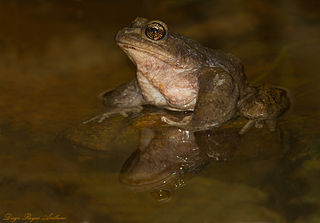Related Research Articles

Protoreaster nodosus, commonly known as the horned sea star or chocolate chip sea star, is a species of sea star found in the warm, shallow waters of the Indo-Pacific region. They are sometimes seen in the marine aquarium trade.
Dichelobacter nodosus, formerly Bacteroides nodosus, is a Gram-negative, obligate anaerobe of the family Cardiobacteriaceae. It has polar fimbriae and is the causative agent of ovine foot rot as well as interdigital dermatitis. It is the lone species in the genus Dichelobacter.

Alsodes nodosus is a species of frog in the family Alsodidae endemic to central Chile; records from Argentina are not considered valid.

Potamogeton nodosus is a species of aquatic plant known by the common names longleaf pondweed and Loddon pondweed. It is native to Eurasia and the Americas, where it is widespread and can be found in water bodies such as ponds, lakes, ditches, and streams. This is a perennial herb producing a thin, branching stem easily exceeding a meter in maximum length. The leaves are linear to widely lance-shaped and up to 15 centimeters long by 4 wide. Both floating leaves and submerged leaves are borne on long petioles, a distinguishing characteristic. The inflorescence is a spike of many small flowers arising from the water on a peduncle.

Simosaurus is an extinct genus of marine reptile within the superorder Sauropterygia from the Middle Triassic of central Europe. Fossils have been found in deposits in France and Germany that are roughly 230 million years old. It is usually classified as a nothosaur, but has also been considered a pachypleurosaur or a more primitive form of sauropterygian.

Nodipecten nodosus, or the lion's paw scallop, is a species of bivalve mollusc in the family Pectinidae. It can be found along the Atlantic coast of North America, ranging from Cape Hatteras to the West Indies, including Brazil and Bermuda.
Streptomyces nodosus is a bacterial species in the genus Streptomyces.
Morimopsini is a tribe of longhorn beetles of the subfamily Lamiinae. It was described by Lacordaire in 1869.
Monoxenus is a genus of longhorn beetles of the subfamily Lamiinae, containing the following species:
Monoxenus bicristatus is a species of beetle in the family Cerambycidae. It was described by Stephan von Breuning in 1939.
Monoxenus elongatus is a species of beetle in the family Cerambycidae. It was described by Stephan von Breuning in 1939.
Monoxenus spinosus is a species of beetle in the family Cerambycidae. It was described by Stephan von Breuning in 1939.
Monoxenus multituberculatus is a species of beetle in the family Cerambycidae. It was described by Stephan von Breuning in 1942.
Monoxenus nigrofasciaticollis is a species of beetle in the family Cerambycidae. It was described by Stephan von Breuning in 1967. It is known from Kenya. It feeds on Juniperus procera.
Monoxenus nigrovitticollis is a species of beetle in the family Cerambycidae. It was described by Stephan von Breuning in 1956.
Monoxenus tridentatus is a species of beetle in the family Cerambycidae. It was described by Per Olof Christopher Aurivillius in 1903 and is known from Cameroon.
Monoxenus balteatus is a species of beetle in the family Cerambycidae. It was described by Per Olof Christopher Aurivillius in 1903.
Monoxenus turrifer is a species of beetle in the family Cerambycidae. It was described by Per Olof Christopher Aurivillius in 1914.
Monoxenus bispinosus is a species of beetle in the family Cerambycidae. It was described by Karl Jordan in 1894, originally under the genus Apomempsis. It is known from Cameroon, Equatorial Guinea, Gabon, the Democratic Republic of the Congo, the Republic of the Congo, and the Central African Republic.
References
- ↑ BioLib.cz - Monoxenus nodosus. Retrieved on 8 September 2014.